
Kudankulam NPP's Unit 1 and 2 receive new type of fuel from Russian company

Kudankulam NPP, India’s largest nuclear power station’s unit 1 and 2 received a new type of fuel from Russian company.
Russia-based TVEL Fuel Company of ROSATOM has supplied the first batches of the more reliable and cost-efficient TVS-2M nuclear fuel to two functioning units-1&2 of Kudankulam NPP powered by VVER-1000 reactors.
After refueling in July 2022, the Unit 1 will start its operation in an 18-months fuel cycle. With this, TVEL will fulfill its agreement with Department of Atomic Energy (DAE)/Nuclear Power Corporation of India Limited (NPCIL), to implement TVS-2M nuclear fuel with 18-months operating cycles for KKNPP.
The TVS-2M nuclear fuel has several advantages over the old type of fuel.
A press release issued by Rosatom said compared to the UTVS fuel model, which was supplied to Kudankulam NPP previously, TVS-2M fuel assemblies have a number of advantages making them more reliable and cost-efficient.
“First, it is the rigidity of a bundle: because of the welded frame, the fuel assemblies in the reactor core retain their geometry, the spacer grids protect fuel rod cladding from fretting wear (preventing from depressurization), and the additional spacer grid makes fuel assemblies more vibration-resistant. Secondly, the new fuel has increased uranium capacity-one TVS-2M assembly contains 7.6 per cent more fuel material as compared to UTVS. Besides, the special feature of the Kudankulam fuel, in particular, is the new generation anti-debris filter ADF-2, efficiently protecting fuel assemblies.”
Also read: 2 new units of Kudankulam nuclear project to be built by L&T
Operation in longer fuel cycles also enhances economic efficiency of a plant, as reactors have to undergo stoppage and refuelling less frequently, so the power units produce more electricity. Besides, the power plant needs to purchase less fresh fuel, and as a result, has to deal with smaller amounts of spent nuclear fuel, which also requires expenses.
“We offer to our foreign clients the solutions which have proved successful performance at the Russian nuclear power plants. TVS-2M fuel is efficiently operated in 18-months fuel cycle at Rostov NPP and Balakovo NPP in Russia, as well as in Tianwan NPP in China,” said senior vice-president Alexander Ugryumov
Fuel bundles with ADF-2 anti-debris filters have also shown good results at Rostov NPP. Besides, all VVER-1000 reactors in Russia operate at higher capacity, 104 per cent of the nominal, and this experience is also a matter of interest for nuclear power plants operators abroad, he said.
Up to May this year, unit 1 has generated a total of 39,007 million units of power and unit 2, 25,539 million units as per the NPCIL website. In the first two months of this financial year, unit 1 has generated 1,450 million units and unit 2, 22 million units, as it is under maintenance.
Russia is building the KNPP under an Inter-Governmental Agreement (IGA) of 1988 and the later agreements in 1998 and 2008. The first stage, consisting of power units 1 and 2, was commissioned in 2013 and 2017, respectively. Power units 3,4 and 5,6 are the second and third stages of KNPP, which are currently under construction.


